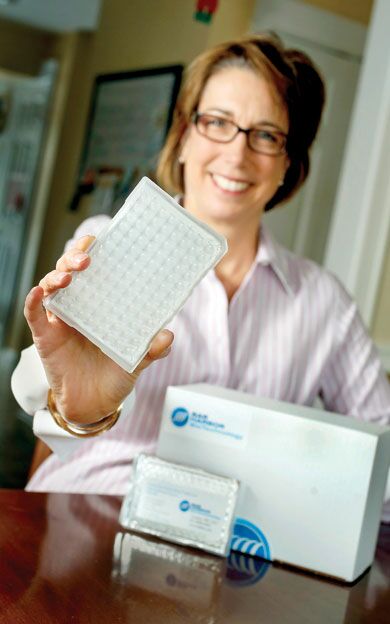Building a brand: Bar Harbor BioTechnology aims to make a name in genetics tools
 Photo / Tim Greenway
Janet Yancey-Wrona, CEO of Bar Harbor BioTechnology, was hired in July to help the company improve its brand recognition and grow its gene-analysis tool business.
Photo / Tim Greenway
Janet Yancey-Wrona, CEO of Bar Harbor BioTechnology, was hired in July to help the company improve its brand recognition and grow its gene-analysis tool business.
Bar Harbor BioTechnology Inc., the private spinoff from The Jackson Laboratory, started strong and fast out of the gate in 2006, moving quickly to accrue nine individual and institutional investors (two of whom provided a multimillion dollar Series A financing), plus two Maine Technology Institute awards totaling $770,000 to fund its gene analysis tool development. But a confluence of factors soon stunted its expansion in a high-growth part of the genetics market. The company regrouped last summer, changing top management and splitting off one of its businesses.
One of the stumbling blocks was a major deal with an international distributor that initially looked like it would fan BHB's growth flames worldwide. While the arrangement did attract international customers, particularly in Europe, it did not promote the company's brand. Instead, the products were sold under the name of the distributor, Swiss biomedical company Lonza.
Further obfuscating matters, the Trenton-based company had two product lines — tools and diagnostics — that confused potential investors. The result: with its growth limited, it split with its distributor, separated the diagnostics business into a new company and in July hired a new CEO, Janet Yancey-Wrona. She says the goal is to get the company's brand known and to focus on and grow its gene analysis tool business. Yancey-Wrona was the founding president of MTI, and previously worked for Maine Manufacturing LLC, AIKO Biotechnology and IDEXX Laboratories.
“The plan for BHB is very much as a restart. We have a product and a book of business,” she explains. “Our level of business isn't profitable yet, with all the changes. The company didn't have leadership for a year while we hammered out agreements, and it had no sales manager.”
BHB makes genetic tests and software for researchers to study which genes are turned on or off in a certain medical condition, like diabetes. The degree to which genes are turned on or off, also known as gene expression, is thought to be at the root of many diseases.
BHB's products use a technique called quantitative polymerase chain reaction, or qPCR, which involves placing biological samples called “primers” into 96 or 384 tiny wells on a plate that the company sells under the brand “StellARray.” Those primers can increase one or more copies of a piece of DNA thousands or millions of times, making the genetic material easier to study and the results more sensitive and accurate, Yancey-Wrona says. The data telling how a gene is expressed is then analyzed by the company's Global Pattern Recognition data analysis software to provide information to customers about gene expression.
The qPCR technique is widely used by laboratories, pharmaceutical and biotechnology companies for gene expression research to understand disease and/or to create drugs or diagnostics. New York-based market research firm Karlorama Information estimates the total worldwide market for qPCR products in 2013 was $3.2 billion, and it expects that business to grow 7.9% from 2013 to 2018.
BHB still is a small player in that market, which is dominated by giant, multi-national companies like Qiagen N.V. of The Netherlands. Still, Yancey-Wrona sees that as an edge for her small company. She says BHB can be more nimble than the larger companies in what she sees as a growth area for her company: producing custom primer plates, also known as arrays. Someone who is researching diabetes, for example, may have studied 96 genes on an array, but may want to look at 50 more. BHB could make a custom array including those extra genes. “It is hard for the big companies to do this custom work,” she says.
But she wants to broaden the product pipeline beyond the company's current market niche.
“BHB could grow to a certain point with our research tools,” she says. “My plan is to stabilize sales of existing products and do more customization.”
Part of her plan to grow the company is to add more products that are part of the workflow performed by scientists using BHB's existing products. That could include the reagent chemicals customers add to BHB's primer arrays to prompt the chemical and biological reactions they are studying. “We need to start to grow our product pipeline, and are looking at others parts of the process,” she says.
She hopes the company, which has annual sales of less than $5 million, will turn a profit this year.
“But nobody knows our name. We need brand awareness,” she says, adding that BHB recently redesigned its website to push more sales and marketing. It also is attending trade shows and getting the word out in customer testimonials.
To raise BHB's profile, she also is giving technical talks at research institutions, such as the National Cancer Research Institute, and participated in the MTI Tech Walk.
Dividing to grow
It was difficult for BHB to raise money when it had both the genetics tools and diagnostics businesses, which have very different investment and growth profiles, she says. “Our investors and founders said raising money for diagnostics, which has more risk and reward, is different than selling a tool for research, which has less risk and reward,” she says.
BHB's investors and founders decided to separate the two businesses, spinning out the diagnostic group into a Hanover, N.H.-based company, Genextropy Inc. Both BHB and Genextropy retain certain rights to The Jackson Laboratory algorithm patents that cover a way to analyze gene expression data from qPCR.
Initially, the investors in both companies overlapped, but since last summer, one of BHB's major and founding investors, Borealis Ventures of Portsmouth, N.H., put all its money into Genextropy. Borealis worked with The Jackson Laboratory from the start to identify the market opportunity and set up the company.
A later investor in BHB, the Maine Venture Fund, kept its investment in both companies, with more in BHB than Genextropy. “We're very happy with what we are seeing now,” says John Burns, managing director of the Maine Venture Fund. “The restructuring was good and smart for BHB and Genextropy.”
He recalls that “things got off to a tough start,” for BHB. About two years after the company started, it signed the distribution deal with Lonza. The deal gave BHB access to a worldwide salesforce, but Burns questions how much incentive the big company had to sell the products, as it also sold other similar products.
“It [the deal] wasn't handled well on either side. It was an exclusive deal that unwound in 2013,” he says. “It was primarily Lonza's brand. BHB was locked into the relationship for four years, and sales struggled.”
However, during those years, BHB's scientists came up with interesting findings to predict certain diseases with proprietary tests using The Jackson Laboratories technology, he says. That diagnostic business led to Genextropy being created about three years ago to develop predictive, non-invasive genetic risk-assessment tests for cancers, autoimmune diseases, neurodegenerative diseases and metabolism disorders.
“The two businesses were very different,” says Burns. “Genextropy takes millions of dollars in investment and years to develop.”
No new cash was put into BHB during the restructuring, but Yancey-Wrona says the company will need more money to grow its brand awareness and sales. Burns will be watching how it does.
“We're looking for trend lines in the product, sales and pipeline to see if and how much funding the company needs and when,” Burns says. He says BHB's products have some unique technical features that are superior to those of competitors, and its prices are competitive.
He says BHB's board and investors hired Yancey-Wrona “because she has a PhD in science, because of her leadership [former MTI president] and because she knows how to manage and grow an organization and engender loyalty.” The board comprises Mary Riley of Lonza, Ed Robinson of indoor aquaculture company Acadia Harvest Inc., along with observers Dan Corey of Bioline Inc., Bob Seitz [cofounder of Applied Genomics], consultant Linda Diou, Maine Venture Fund entrepreneur-in-residence Des Fitzgerald and John Tonkinson of The Jackson Laboratory.
“Janet is surrounded by a sound team,” Burns says.
Building a brand
BHB never had much sales and marketing of its own, Yancey-Wrona explains. “But they maintained a decent amount of business and research.” At least half of the company's sales are from outside the United States, mainly Europe, because of Lonza. Among its customers — primarily academics and some pharmaceutical companies — the company also is known because researchers have published more than 100 scientific papers mentioning its products as part of their work. Those publications can help give the company's products credibility and notice among its target customers.
“To sell to researchers, we first needed a website. We're getting these orders — they're up from 2014 over 2013 by about 20%,” she says, though she would not reveal exact sales figures. “And that's with a limited effort.”
She also will expand distribution and start an emailing marketing campaign, eventually hoping to get distributors on the West Coast. BHB signed four distributors in Europe in the past four months, but Yancey-Wrona says getting distributors in North America has been difficult.
“We're open to opportunities. We must prove the value of our products now, and the company must be stable and sustainable,” she says. With prices 20% to 30% below the competition, even with custom plates, she figures she can entice potential customers to try BHB's products, and even give a promotion for referring a friend. The company will need to double or triple its sales to turn a profit. “The company goal is in the $10 million to $15 million range longer term, with more than one product. That's in our three- to five-year plan,” she says.
Yancey-Wrona adds that she does expect to seek a small round of funding, maybe $100,000 to $250,000. “It's easier to raise small amounts of money. It'd be more difficult in the $5 million to $10 million range,” she says.
“To grow these products, I need resources to put behind sales and marketing,” she says, adding that she will tap existing funders, including the Maine Venture Fund, angel investors, friends and family.
Read more
Jackson Lab and its new CEO build a better mouse
Genotyping center helps researchers find the right mice
Lab software startup founded by Jackson Lab employees gets key $220K grant










Comments